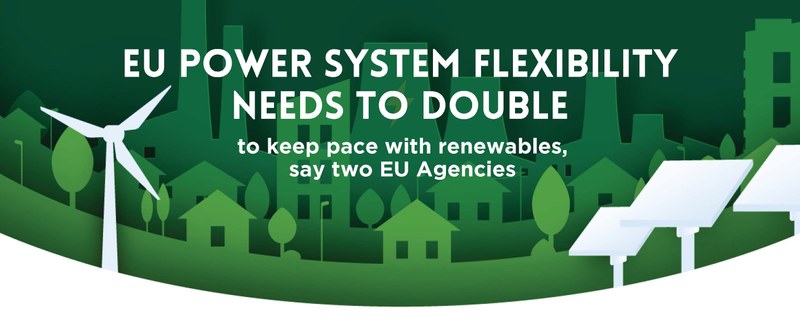All official European Union website addresses are in the europa.eu domain.
See all EU institutions and bodiesEU Member States need to massively ramp up their renewable power capacity in the coming years. This increase in renewables from variable sources, such as wind and solar, will also increase the need for ‘flexibility’ in the EU electricity system. A joint report released today by two EU agencies, EEA and ACER, demonstrates how Member States could exploit collaboration synergies to unlock flexibility and enhance energy security while contributing to long-term climate neutrality. Key levers include better cross-border planning and forecasting, enhanced use of interconnectors as well as financial incentives and reliable information for electricity consumers to adapt demand when needed.
With the EU 2030 renewables target of 42.5% (compared with 22% in 2021), this decade will see an accelerated decarbonisation of EU electricity supply. A joint report by the European Environment Agency (EEA) and the EU Agency for the Cooperation of Energy Regulators (ACER) underlines the need to double the 'flexibility' of Europe’s power system to keep pace with the growth in renewables from variable sources, such as wind and solar.
Flexibility is the power system’s ability to adjust to the fluctuating generation and consumption of energy. Flexibility can be provided in different timeframes, such as days, weeks or seasons and by different technologies. Currently, peak generation gas plants provide much of the flexibility but with the clean energy transition, other types of flexibility resources are needed from both the demand and supply side. Meeting the flexibility challenge facilitates deployment of renewables and brings benefits to European Member States and consumers.

The report underlines that:
- Flexibility in the EU power system needs to almost double by 2030 to keep up with the growth of variable renewable electricity sources.
- Enhanced electricity interconnection is key. More grids should be built across borders and the existing grid capacity used better. Interconnectors facilitate the efficient flow of electricity across borders to where it is most needed. Existing and planned interconnectors facilitate flexibility to be shared across border and in 2030 could reduce the need for power supply by an amount equivalent to the electricity consumption (in 2022) of Sweden.
- A combination of demand response and energy savings not only reduces energy bills but also provides much needed flexibility, thus facilitating renewables and supporting Europe’s security of energy supply. In 2030, better demand response and energy savings could reduce the need for power supply from sources other than wind and solar by an amount equivalent to the 2022 electricity consumption of Spain.
- Allowing price signals to drive investments and consumer behaviour is key. Consumers also need reliable information to make well-informed choices.
- The EEA-ACER report calls for Member States to better assess and have complementary national and EU-wide assessments of flexibility needs (as currently being discussed by Europe’s co-legislators in the electricity market design reforms).
- To foster common policies across borders, Member States could introduce regional cooperation on flexibility into their National Energy and Climate Plans (NECPs), and include detailed energy data in their greenhouse gas emission projections.
The EEA-ACER report “Flexibility solutions to support a decarbonised and secure EU electricity system” is presented by the EU Agencies at today’s (20th October) meeting of Member States’ Energy Director Generals in Madrid, under the Spanish Presidency of the Council of the EU.
Notes for editors
- ACER is the EU Agency for the Cooperation of Energy Regulators: www.acer.europa.eu.
- EEA is the European Environment Agency: https://www.eea.europa.eu.
- Renewables help meet Europe’s dual goals of (1) climate targets of reaching net-zero emissions by 2050; and (2) secure energy supply. But with the ramp-up in solar and power generation (which have weather-dependent variable output), much more flexibility is needed.
- Flexibility in this report means the interconnected EU power system’s ability to adjust to the fluctuating generation and consumption of energy. Today, much of the flexibility that balances and provides stability to the power systems come from fossil fuels (e.g. gas). In the clean energy future, the power system needs to match demand and renewable supply by using more climate-compatible flexibility solutions across the system.
- Climate-compatible flexibility can be provided in different timeframes and by different technologies. Very promising (clean) flexibility solutions exist (e.g. demand response or energy storage) and need to be further unlocked. All types of flexibility are needed: small active consumers and storage providers (from pumped hydro storage to new technologies such as batteries) are needed as well as big industrial consumers who can reduce consumption peaks and clean generation.
- Demand flexibility includes households adjusting their consumption or smart-charging Electric Vehicles (EVs), prosumers (i.e. consumers who also produce electricity e.g. through solar roof tops), commercial demand shifting their demand away from periods when it is scarce to when it is cheaper and in more supply, and space heating (for example in energy efficient buildings).
- Supply-side flexibility includes clean technologies such as electricity storage, hydropower plants, power from renewable hydrogen and others which can generate electricity at short notice.
Press contacts
EEA
Mr Constant Brand
Constant.Brand@eea.europa.eu
Mr Antti Kaartinen
Antti.Kaartinen@eea.europa.eu
LinkedIn: EEA

